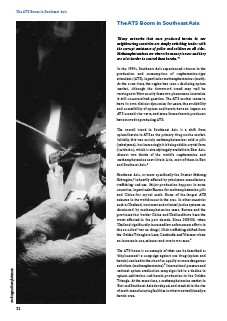The ATS Boom in Southeast Asia
January 2009
 In the 1990s, Southeast Asia experienced a boom in the production and consumption of amphetamine-type stimulants (ATS), in particular methamphetamines (meth). At the same time, the region has seen a declining opium market, although the downward trend may well be versing now. How exactly these two phenomena interrelate is still an unresolved question. The ATS market seems to have its own distinct dynamics; for users, the availability and accessibility of opium and heroin have an impact on ATS use and vice versa, and some former heroin producers have moved to producing ATS.
In the 1990s, Southeast Asia experienced a boom in the production and consumption of amphetamine-type stimulants (ATS), in particular methamphetamines (meth). At the same time, the region has seen a declining opium market, although the downward trend may well be versing now. How exactly these two phenomena interrelate is still an unresolved question. The ATS market seems to have its own distinct dynamics; for users, the availability and accessibility of opium and heroin have an impact on ATS use and vice versa, and some former heroin producers have moved to producing ATS.
![]() Download the report (PDF)
Download the report (PDF)
The overall trend in Southeast Asia is a shift from opium/heroin to ATS as the primary drug on the market. Initially, this was mainly methamphetamines sold as pills (yaba/yama), but increasingly it is being sold in crystal form (ice/shabu), which is already largely available in East Asia. Almost two thirds of the world's amphetamine and methamphetamine users live in Asia, most of them in East and Southeast Asia.
Southeast Asia, or more specifically the Greater Mekong Subregion, is heavily affected by yaba/yama manufacture, trafficking and use. Major production happens in some countries, in particular Burma for methamphetamine pills and China for crystal meth. Some of the largest ATS seizures in the world occur in the area. In other countries such as Thailand, treatment and criminal justice systems are dominated by methamphetamine cases. Burma and the provinces that border China and Thailand have been the worst affected in the past decade. Since 2003/04, when Thailand significantly increased law enforcement efforts in the so-called 'war on drugs', illicit trafficking shifted from the Golden Triangle to Laos, Cambodia and Vietnam where an increase in use, seizures and arrests was seen.
The ATS boom is an example of what can be described as 'displacement': a campaign against one drug (opium and heroin) can lead to the rise of an equally or more dangerous substitute (methamphetamine). International pressure and national opium eradication campaigns led to a decline in opium cultivation and heroin production in the Golden Triangle. At the same time, a methamphetamine market in East and Southeast Asia developed, and resulted in the rise of meth manufacturing facilities in what was traditionally a heroin area.
This chapter was originally published in: Withdrawal Symptoms in the Golden Triangle - A Drugs Market in Disarray, Transnational Institute, January 2009.







